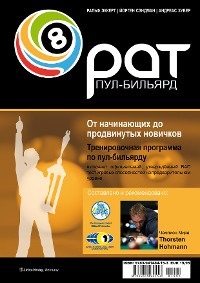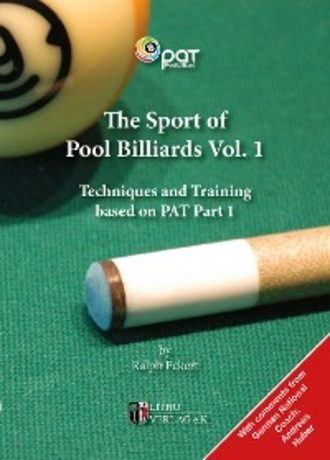
Полная версия
The Sport of Pool Billiards 1
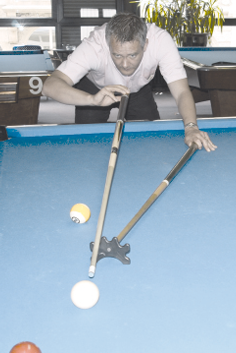
Standard rest for shots that are so far away that you would have to practically lie on the table ´to reach them. The old rule that one foot has to touch the floor still applies – and rightly so!
21

Chapter 1
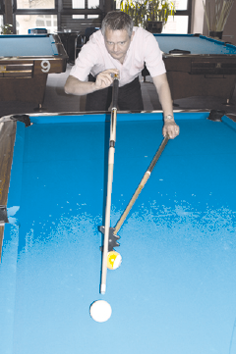
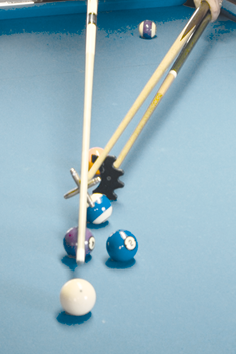
The important thing is to make sure you can still hold the two cue ends firmly in you hand.
Andreas Huber, German national coach:
Playing with a rest must be practiced regularly at virtually every level. Just play for an hour every now and then using one.
Standard rest held up-right to avoid intervening object balls
A cross bridge is guided over a standard rest held upright so that even larger intervening objects can be avoided.
22

Training program
Training Program
(based on PAT 1, officially recommended by the WPA!)
The Playing Ability Test (PAT 1-3) was developed in spring 2003 and since fall 2004, following its recognition by official billiard sport associations all over the world, has been officially recommended by the World Pool Billiards Association (WPA)!
The PAT 1 program and test serves as a sound basic guideline for learning to play a good game of pool billiards. If you like, you can now skip the next few sentences and go straight on to the first topic or exercise. Or you can read on and learn something about the PAT System.
The WPA awards official colored emblems on the basis of points individually attained in these 3 tests so that, like in the martial arts judo and karate, you can see what level a player is at! In billiards, though small emblems were considered more appropriate.
The emblems bear the inscription Sport & WPA in the color for your level.
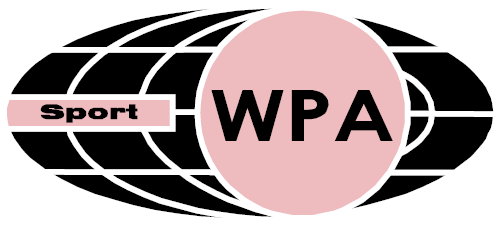
23

Chapter 2
More details about how to get a color emblem and about PAT in general can be found under: www.pat-billiard.com
All the skills you need in order to play a good game of pool billiards are included in these three tests and have been sub-di-vided into ten areas. Each of these areas is tested through spe-cific exercises. Depending on your score you can see whether you require more training in this area or whether you can go on to another area. For each exercise in each area a target score is given. Your total points attained is a percentage of the target score. It should be added that it is also possible to get more than the target score (i.e. more than 100% is possible).The target – or rather the ideal value – for the ten separate areas is therefore 10 x 100% - a round 1000%. Theoretically, including the extra points mentioned above, the maximum score in PAT 1 is 1,549 points.
The areas tested in PAT 1 and 2 are basically identical. They differ only in the level of difficulty, exercises and the target values required. PAT 3, which is not dealt with here, includes more advanced exercises requiring special skills.
PAT 3 is aimed at top class players who play at national league level and also professional players.
In this book, the exercises in the ten different areas are de-
PAT Start:
PAT 1:
PAT 2:
PAT 3:
White (600 Points) and black & white (800 Points)
Light green (600 points) and dark green (800 points)
Light blue (600 points) and dark blue(800 points)
Black (550), red (700), gold (850) and pink (from 1000)
Recreational players
Sportsmen
Professionals
Colors


24

Training program
signed to help a beginner to become an advanced player. PAT 1 is taken after the player has practiced all these areas. PAT Start is not officially represented as such here, but is dealt with in the form of exercises leading up to PAT 1, although they are not the original PAT Start exercises.
Advanced players should orientate themselves in this book more towards the alternative or more advanced exercises described under the ten sections, which lead up to PAT 2.
If you are unsure whether you are an advanced player or not, I recommend you play through PAT 1 first of all. Depending on the average points value scored and the comparison with the target values(from about 80% is fine and will take you on to PAT 2, less than 50% means you need more training and sends you back to PAT Start or to the „lead-up“ exercises described here), you should be able to find out where to start without any trouble. During a test all the exercises are played through with the appropriate number of attempts and innings and the results noted.
The first four areas of PAT 1 deal with the quality of the shot and look at speed, straightness and the effect of the shot (follow and draw shots).
The next six chapters deal with the game itself: Small and large positions, frozen rail situations, continuous position games, your movement cycle including shooting accuracy, and finally practical applications. These ten areas can be easily found under the relevant chapter headings! So, all that remains is to say good luck and have fun!
25

Chapter 2
PAT drills Procedure Your score = your Ø Target Ø Maximum Ø
1. Speed 3 innings @ 4 speeds 3.0 – 3.5 4.0
2. Straightness 4 innings @ 3 shots 2.2 – 2.6 3.0
3. Follow shot 3 innings @ 6 follow shots 8.0 – 10.0 12.0
4. Draw shot 3 innings @ 6 draw shots 8.0 – 10.0 12.0
5. Small position 2 x 3 attempts @ 5 balls 3.0 – 4.0 5.0
6. Large position 2 x 3 attempts @ 6 balls 3.0 – 4.0 6.0
7. Frozen rail situations 2 x 3 attempts @ 6 & 10 balls 4.0 – 6.0 8.0
8. Continuous drill 3 innings @ 3 x 3 balls 4.0 – 6.0 9.0
9. Movement cycle 5 standards balls @ 3 shots 1.8 – 2.2 3.0
(Standard balls)
10. Game situations 3 x 1 attempts @ on 9 balls each 3.8 – 5.0 9.0
Ø = sum of final results achieved divided by the number of innings or attempts.
26

Training program
You can write your results down on any piece of paper, but there is also a more luxurious alternative. Official pool billiard workout books are available with score sheets for each test, exact target averages, factors for working out exact averages as well as training programs with a structured training plan for each exercise.
In addition there are official PAT DVDs in which each individual exercise is not only played (by the 2003 world champion Thor-sten Hohmann) but also explained in detail (by the German coach Andreas Huber and Ralph Eckert). The techniques described in this book can also seen on the DVD!
„There is nothing that cannot be achieved through patience and equanimity. This is an experience we go through every day“
- Mahatma Gandhi -
Founder of the Indian freedom movement and peaceful resis-tance
Taken from his book „He who follows the path of truth will not stumble“ (2002)
27

Chapter 2
Speed
The correct speed is of crucial importance when playing for position! Good players need a great deal of feeling for this and these exercises are designed to help you develop this feeling! Often during training, you will be told to “play very softly”, use “average power”, “hard”, “soft”, “lightly” and so forth.
Andreas Huber, German national coach:
The words „hard“ or „power“ are fatal. You can only achieve the right effect (!!!) through the speed of the stroke – power cannot be transferred in billiards!
To clarify these instructions once and for all and, at the same time, to give you an increased feeling for the right speed, here is a short series of exercises for training speed. Try them out and see if you manage to follow the cue through as I describe. Even experienced sportsmen have problems playing Speed 1 correctly.
Recommended training target: Play the four balls at Speed 1 and 2 again and again until you can play the four balls in sequence at the right speed. With Speed 3 and 4 just play one ball after the other until they all (but not necessarily in order) come to rest in the right speed field.
28

Training program
All 4 balls are to be played one after the other into the marked area, i.e. 4 times in a row. They must not touch the bottom rail, i.e. there is a tolerance of 4 diamonds.
The balls must not touch each other!
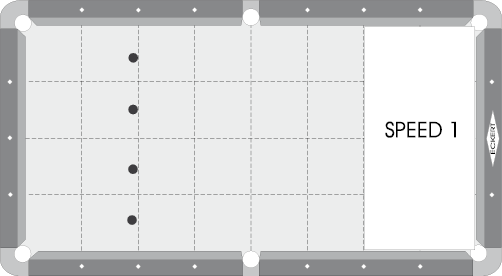
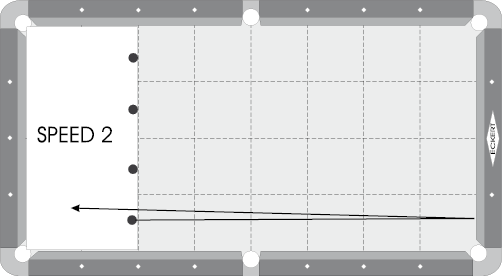
As above! The same tolerance applies! I.e. the balls should roll into the area and may touch the rail (but don‘t have to). The balls must not touch each other!
29

Chapter 2
Again as above, only just a little further (Speed 3)! In this exercise you‘ll have to watch your straightness, too as the balls are not allowed to touch each other or the long cushion!
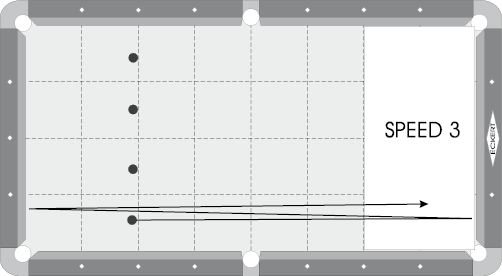
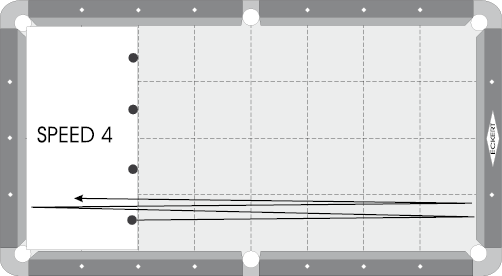
Here again there is a tolerance of 4 diamonds!
There is not usually any need to play a speed stronger than Speed 4. A 9-ball break may require Speed 5 or 6 but this cannot be shown in table lengths because the cue ball would
30

Training program
automatically jump when it hits the first rail. However, interna-tional table rules state that a ball must be able to run 4 table‘s lengths before it jumps.
Now you‘ve done the exercises you should be able to see whether you had any problems playing these speeds or not. At this point, though, we shouldn‘t be worrying about straight-ness. Straightness will be dealt with in the next session. The problem of finding the right speed is usually a question of the right swinging frequency! Where does the strength needed for a clean Speed 4 or higher come from? The upper arm? The forearm? Muscle power? No, it comes from the speed of the cue movement itself. In order to achieve a high speed you have to learn to move the cue „fast“. And to do this, you need to accelerate with the cue. Before you actually contact the ball you should do a few practice swings. I have often had pupils who would have gladly left these practice swings out, or who did them very slowly, quickly or cautiously. But if you do not do any practice swings beforehand, or not enough, then you‘ll generally never be able to get any real acceleration with the shot. The shot usually turns out to be a bit hacked off and rough.
If you swing too slowly, you‘ll find it difficult to hit the cue ball quickly and won‘t be able to achieve the high speeds. On the other hand, if you swing your cue too hastily, too impetuously, you‘ll have problems with the slower speeds! The best thing to do is accustom yourself to an average swinging speed and then you‘ll be able to master all the speeds!
You may be asking yourself how many practice swings are recommended before actually hitting the cue ball. There isn‘t really a simple answer to this. My advice is simply to swing
31

Chapter 2
the cue backwards and forwards as often as you like until your instinct gives you the okay. (If your instinct says „this is no good“, then my advice would be to put the cue down, stand up straight and start again). If your instinct gives you the okay, then pause briefly and start your countdown, for example „1 - 2 -...shoot“. (Take a look at the 7-step procedure under 2.9 Movement cycle.)
Let‘s go through it again:
Once you feel everything is okay (cue resting in forward po-sition) .. move cue back and forwards again (1) .. move cue back and forwards again (2) brief pause .. cue back (some professionals prefer to pause here) .. follow the shot right through until your arm comes to a natural rest!
Andreas Huber, German national coach:
It is incredibly important to prepare yourself slowly, smoothly and, above all, completely before you actually cue the ball – pulling the cue back quickly in order to achieve a greater effect nearly always ends up in catastrophe.
32

Training program
Little differences in style:
Some professionals tend to go „1-...shoot“ or even simply „… shoot“ rather than „1 - 2 -...shoot“! The most important thing is that, once your instinct tells you to play, you accustom yourself to your own preferred method and then stick to it! This way you can be sure that your stroke will always come through from the back in one clean, smooth movement and that you never shoot too impetuously. Some players prefer to take a short pause „at the front“ (i.e. with the cue directly in front of the cue ball) and others „behind“ (with the shooting arm at the rear). Others pause at the front and back. Since no empirical study has been done recommending the one or the other I think it is a matter of personal taste. For me, this „pause“ marks the time I take to fix my gaze on my target. The German national coach Andreas Huber likes to describe this pause as a „mental void“ or a „total inner silence“.
I hope that, with the explanations given here and a bit of prac-tice, you will succeed in mastering the 4 different speeds in this book. You will see that a good feeling for speed will improve your game and your results. But before we start on the PAT exercise (see diagram on next page), here‘s an overview of all the speeds. There are, of course, not just 4 speeds in a game of pool, but an infinite number. The more advanced the player, the more he differentiates his speed! With these 4 definitions, your trainer (and myself later in the book) can describe speed more accurately. Instead of saying „play lightly“ I can say „play with Speed 1.25“ and you will know what I mean because you have done this exercise. Of course, balls roll a different distance on different tables. If you are playing on a new table, you should play through these 4 speeds. You may find that Speed 2.5 requires a firmer stroke than on another table, but
33

Chapter 2
it will always remain Speed 2.5! You have to hit the ball firmly enough so that the ball rolls just under 2½ table‘s lengths. YOU have to adapt to the table, not the table to you! The run of the ball in this diagram should not be taken too literally. It is just an example to illustrate the speed values.
PAT Level 1, Part 1: Speed
After this brief introduction into speed as well as a bit of prac-tice, you can now have a look at the official test exercises and try them out. I advise you to pretend that you are actually taking the official test (although that‘s impossible just with this book, of course) to see where you actually stand.
The same exercise is used for PAT 1 and 2 by the way. The only difference is in the expectations, i.e. the target average required to move up to the next level.
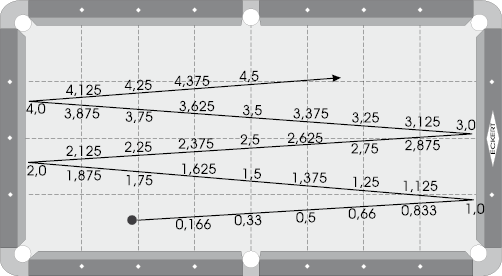
34

Training program
Type and target: As a variation, all 4 different speeds should be played through one after the other!
Basic rules: the table can be divided into four lengthwise sections, marked off by the diamonds and the long outside rail. Each ball must be placed on the head line within their lengthways diamond sections! They do not have to come to rest within their diamond segment but must start there. If you look at the diagram (t006), ball 1 is in the top segment, 2 in the segment below, then 3, then 4. Hitting other ball(s) and the long cushion are not permitted.
Ball 1 is played with Speed 1 (with a tolerance of 2x2 diamonds, as mentioned above). It doesn‘t matter if the bottom rail is touched or not. Ball 2 is played with Speed 2, Ball 3 with Speed 3 and Ball 4, of course, with Speed 4! When you have played through these balls, count how many of the four speeds you managed (all 4, 3, 2 or only 1!). If you have one of the official training manuals you can enter the score in the first field of the score sheet or on a squared pad of paper.
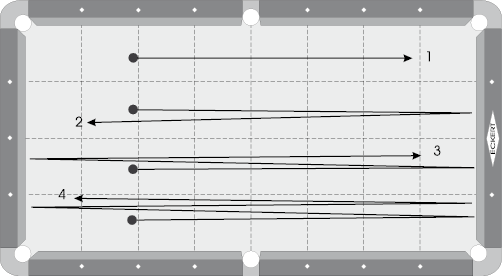
35

Chapter 2
Scoring: Do this exercise three times. Note down how many of the four speeds you achieved in each attempt. None, one, two, three or four? Add up the three results and divide the sum through the 3 attempts. This is your average for this first part of the test. At Level 1 your average should be 3.0 to 3.5 if you want to fulfill the prerequisites to move up to the next level. An average of 3.0 or higher is already advanced! So you now know where you stand and what your medium-term aim should be! The targets always add up to 100%. You need 80% to pass a PAT test. In the official training manuals you will find the exact target values and the factor by which you have to multiply your average in order work out your percentage. So keep on training until you achieve satisfactory results. On the next page there are some additional exercises so that you don‘t have to keep practicing the same thing again and again. That could get tedious!
36

Training program
Recommended target scores are also given.
Alternative:
Play all 4 balls in sequence into the marked area (Speed 0.5).
Play all 4 balls one after the other into the Speed 1.5 field.

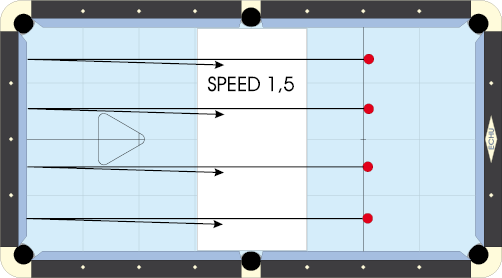
37

Chapter 2
Play all 4 balls one after the other into the Speed 2.5 field.
Play all 4 balls one after the other into the Speed 3.5 area.
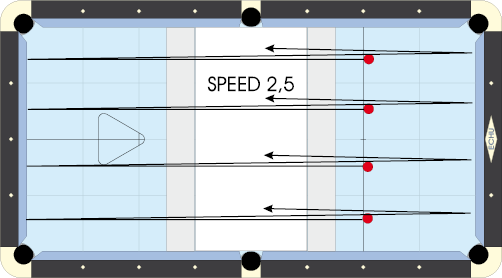
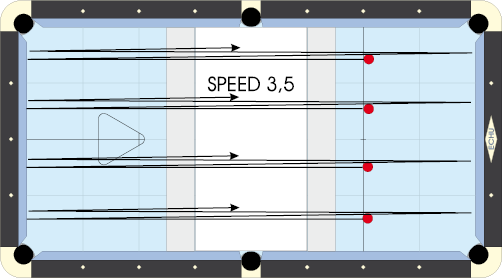
38

Training program
Lead-up:
Here are a few exercises that will help you prepare for the PAT 1 exercises or quite simply help you to develop a good feeling for speed, which is what we are trying to do at the moment.
As you can see there are different „cross speeds“ as well! Be-cause of the loss of momentum caused by friction on contact with the cushion, these speeds are not as fast as the speeds we have been practicing lengthways, but they come quite close! But you‘ve got to master this, too, anyway. Practice these shots for a change, first trying to hit each ball one after the other into the marked area, and then in sequence with no mistakes. If you miss one you have to start at the beginning again.

39

Chapter 2
This is a three-rail shot. Here too, play the ball at each speed. First one after the other (Level 1) and then in sequence as above (Level 2).
Lead-up but a bit more interesting:
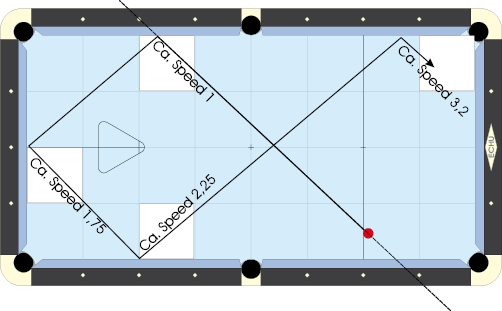
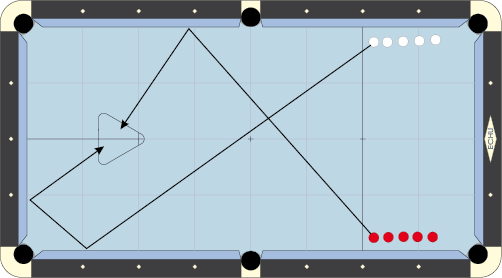
40

Training program
Billiard Curling:
Practicing alone: How many of the ten balls can you place in the marked triangle after hitting at least one rail (the long rail first)?
Two players: One player plays the solids and the other the stripes. In turn each player hits one of his balls. Which player placed the most balls in the marked triangle after 5 balls?
Before each shot the balls may only be placed within the player‘s own head field, (i.e. behind the marked line or the second diamond).
This game is really good fun. I can‘t remember exactly but I think I saw it for the first time (or something similar) at a youth training session in Fulda/Germany run by the successful coach Michael Wahl.




